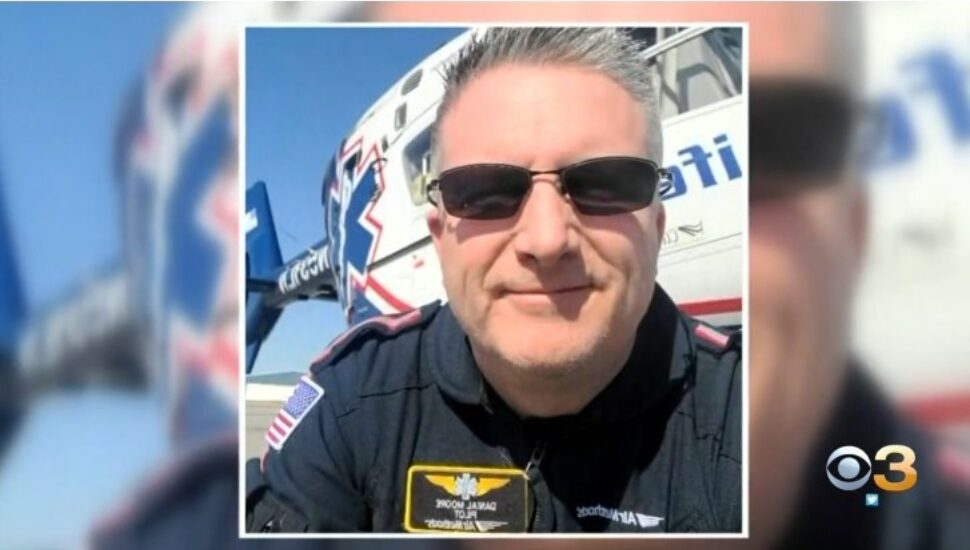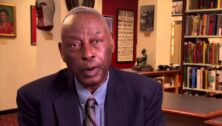Pilot Daniel Moore Gives Personal Account of Drexel Hill Helicopter ‘Miracle’

Pilot Daniel Wesley Moore had less than a minute to save the lives of everyone in a medical helicopter plummeting from 1,500 feet Jan. 11, writes Jeff Taylor for The Northern Virginia Daily.
He aimed for a patch of grass by Drexel Hill United Methodist Church.
While everyone survived the crash, including flight paramedic Kevin Chafee, flight nurse Kris Lawson and the two-month-old that was in an infant pod strapped to a stretcher, Moore was knocked unconscious.
He is recovering from seven broken ribs, four cracked vertebrae, a broken sternum, and a possible concussion.
Moore was attempting something known as a flare technique as he fought the controls of the Air Methods Corp. Eurocopter. To cushion the landing, he was trying to bring up the nose of the EC-135 while slowing the helicopter’s rotor disc.
“The only option I had was to crash as slowly as possible,” he said. “My last moment of recollection before impact was realizing I’d overshot the field and seeing the church coming at us at a high rate of speed and thinking whatever I was trying didn’t work out and we were all about to die.”
Moore said he squeezed between an evergreen tree and utility poles. The copter’s rotor grazed a tree branch and pole as he descended.
The helicopter struck the ground near a vehicle that had three people in it. It then bounced before resting between a utility pole and a stone wall by the church entrance.
The pilot says it was luck and his long flying experience that helped them survive, adding he trains for crash landings on a simulator every six months.
Clear Skies
The majority of Moore’s flights these days involve the transport of adults and children between hospitals. He averages two flights a day.
Moore was flying out of Wellspan Chambersburg Hospital in Chambersburg, Pennsylvania on Jan. 11, taking the two-month-old girl to Children’s Hospital of Philadelphia. The pilot had 4,123 hours of flight time, including 3,400 hours in helicopters and 185 flying Eurocopters under his belt.
It was clear skies and mild weather that day when he took off about 12:05 p.m.
Moore was flying east at 3,500 feet at 12:43 p.m. He descended to 2,800 feet and leveled the helicopter, then descended again to 1,500 feet and leveled, a normal procedure close to your destination, according to the NTSB report.
He was about 10 minutes from CHOP when the trouble started.
Moore doesn’t remember about the crash but knows he didn’t have enough time to make a Mayday call and only had a few seconds to glance at his instrument panel.
“Helicopters don’t like to glide. They like to crash,” Moore said. “The pilot just keeps them from crashing. That’s how we fly them. Airplanes inherently like to fly and helicopters don’t. So you’re constantly making inputs unless you’re on autopilot.”
Moore wanted to land on a road, but there was lunchtime traffic and each block had utility poles with wires.
“About all I can recall is getting control of the aircraft, getting it out of a dive, and then essentially looking for a place to put it down,” he said. “And if you know the neighborhood up there, there weren’t a whole lot of options.”
Chafee and Lawson were treating the baby when they heard a loud bang.
The helicopter banked sharply right, then rolled to the right.
“[Chafee] said that the helicopter rolled inverted, perhaps multiple times and that he and [Lawson] were ‘pinned to the ceiling’ and internal communication was lost,” the report said. “The helicopter was leveled, the patient was secured and the crew members secured themselves in their seats and they braced for landing.”
Chafee called 911 after the crash from inside the helicopter reporting that Moore was conscious but not alert.
Lawson later told Moore’s fiancee, Gail Miller, that he crawled out of the helicopter with the baby wrapped in a blanket and handed it to a Lyft driver at the crash scene. He then went back to get Chafee and Moore out of the wreckage.
The helicopter fuel had ignited, starting a small fire. Chaffee put the fire out with an onboard fire extinguisher while Lawson helped Moore who had fallen through the left door and was underneath the downed helicopter.
Chafee got in an ambulance with the baby and Lawson was able to drag Moore from the wreckage.
The next thing Moore knew, he was surrounded by firefighters who were cutting off his flight gear.
“I remember asking one of them, ‘Is this real?’ And that’s when Kris, while he was cutting off my flight suit, said, ‘Hey, we crashed,’” Moore recalled. “I asked Kris how my crew was and he said, ‘I’m your crew (expletive).”’
Moore expects to fully recover in about eight weeks and he intends to return to flying.
In all this, the most important thing to him was that the baby and his crew survived intact.
“I’ll take that any day of the week,” he said. “The fact that all of us are here to talk about is pretty miraculous considering the situation. I’m just happy we had a lot of divine intervention combined with some luck and a little bit of pilot skill.”
The 51-year-old got his pilot’s license in 1988, flying for the Virginia Army National Guard. He’s a member of the Army National Guard 224th Aviation Unit in Fort Belvoir in Fairfax County.
He’s also flown as a private airline pilot from 2017-20.
Moore grew up in Mound, Minnesota, and has dreamed of flying since age 12, when his father paid for Moore to fly in a Bell 47, a single-rotor helicopter.
His father, Larry Moore, flew UH-1 helicopters, Hueys, during the Vietnam War, retiring from the Army National Guard as a lieutenant colonel.
Read more of pilot Daniel Moore’s interview at The Northern Virginia Daily.
This news report from 6abc includes an interview with the Lyft driver who was handed the baby at the crash scene.
Stay Connected, Stay Informed
Subscribe for great stories in your community!
"*" indicates required fields






![ForAll_Digital-Ad_Dan_1940x300[59]](https://montco.today/wp-content/uploads/sites/2/2022/06/ForAll_Digital-Ad_Dan_1940x30059.jpg)




![95000-1023_ACJ_BannerAd[1]](https://montco.today/wp-content/uploads/sites/2/2023/03/95000-1023_ACJ_BannerAd1.jpg)





























